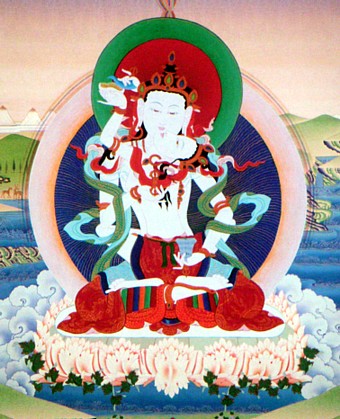Sambhogakaya: Difference between revisions
Jump to navigation
Jump to search
No edit summary |
mNo edit summary |
||
| Line 1: | Line 1: | ||
[[Image:VajrasattvaLarger.jpg|frame|[[Vajrasattva]] adorned with the [[thirteen ornaments of the perfect sambhogakaya]]]]'''Sambhogakaya''' (Skt. ''saṃbhogakāya''; Tib. ''longku''; Wyl. ''longs sku'') is defined as a 'form [[kaya|body]]' ([[rupakaya]]) of a [[buddha]], which appears only to [[bodhisattva]]s and is the basis for the arising of the [[nirmanakaya]]. It is adorned with the [[major signs and minor marks]]. | [[Image:VajrasattvaLarger.jpg|frame|[[Vajrasattva]] adorned with the [[thirteen ornaments of the perfect sambhogakaya]]]]'''Sambhogakaya''' (Skt. ''saṃbhogakāya''; Tib. ''longku''; [[Wyl.]] ''longs sku'') is defined as a 'form [[kaya|body]]' ([[rupakaya]]) of a [[buddha]], which appears only to [[bodhisattva]]s and is the basis for the arising of the [[nirmanakaya]]. It is adorned with the [[major signs and minor marks]]. | ||
[[Sogyal Rinpoche]] writes: | [[Sogyal Rinpoche]] writes: | ||
:Sambhogakaya is the dimension of complete enjoyment, the field of total plenitude, beyond dualistic limitations and beyond space and time.<ref>''[[The Tibetan Book of Living and Dying]]'' revised and updated edition (HarperSanFrancisco and London: Rider, 2002), page 347.</ref> | |||
==Notes== | |||
<small><references/></small> | |||
==Internal Links== | ==Internal Links== | ||
Revision as of 16:59, 4 September 2009

Sambhogakaya (Skt. saṃbhogakāya; Tib. longku; Wyl. longs sku) is defined as a 'form body' (rupakaya) of a buddha, which appears only to bodhisattvas and is the basis for the arising of the nirmanakaya. It is adorned with the major signs and minor marks.
Sogyal Rinpoche writes:
- Sambhogakaya is the dimension of complete enjoyment, the field of total plenitude, beyond dualistic limitations and beyond space and time.[1]
Notes
- ↑ The Tibetan Book of Living and Dying revised and updated edition (HarperSanFrancisco and London: Rider, 2002), page 347.